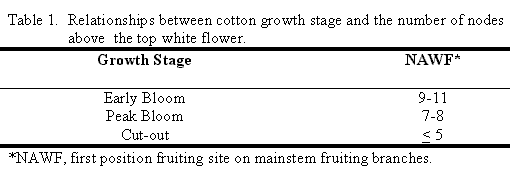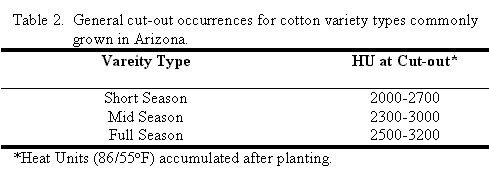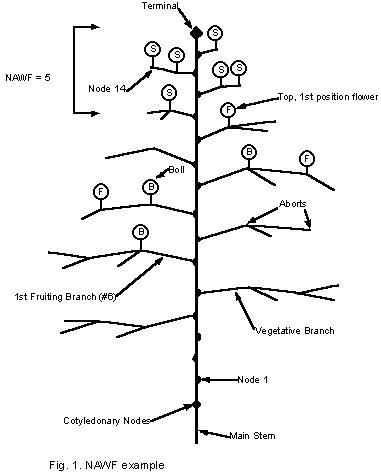Deciding on the Final Irrigation
(Publication az1212)
(PDF file version, 35KB)
by Jeffrey C. Silvertooth,
Extension Agronomist - Cotton
In deciding on the timing of the last irrigation, the best thing to follow is the crop first and the calendar second. In this sense, the best thing to watch for is the progression of the crop towards, and into cut-out. Counting the number of nodes above the top (first position) white flower (NAWF) provides an easy and reliable estimate of crop maturity and the onset of cutout (Figure 1). Generally, as the NAWF becomes 5 or less, the crop is progressing directly into cutout (Table 1). Timing of cutout can be estimated by tracking heat units accumulated after planting (HUAP, 86/55° F thresholds). Table 2 provides the range of HUAP required for cutout for the three general variety types. The range in HUAP for cutout is due to a number of factors including the variety, the position of the first fruiting branch, fruit retention levels, crop stresses, etc.
When the NAWF approaches 5 or less, it is a good time to assess the overall situation in terms of general crop condition, as well as current pest pressures. If a more indeterminate (full-season) variety is being grown, the grower has an option of pushing the crop on towards a top-crop. If the variety is a medium or short season type, the top-crop potential is more limited in this respect and decisions concerning the last irrigation need to be made. In general, a reasonable top-crop potential exists when a) total fruit retention is about 40% or less, b) the variety is a long-medium or full season type, and c) the crop has plenty of vigor (adequate HNR). From recent research in Arizona, with common Upland and Pima varieties, it takes about 600 heat units (HU) for a bloom to develop into a full-sized, hard boll (fiber length development is complete). In July, August, and early September, the accumulation of 600 HU translates roughly to 21 days for most cotton growing areas of Arizona. An easy and direct approach for determining the final irrigation for a crop can start with a good field evaluation to determine the last set of blooms that one intends realistically to take to harvest. When that decision is made, the last set of blooms should be given at least three weeks of good plant-water conditions, or available soil moisture to complete their development to a full sized boll. In this regard, actual HU accumulations should be followed as well as the development of the last bolls intended for harvest. The number of irrigations that this will require will depend upon the soil texture (soil water holding capacity), the amount of water applied in an irrigation, and the soil water depletion rate.
Since irrigation water is often one of, if not the most expensive item in many Arizona cotton production systems, making the last irrigation can be a very important economic decision. Additional irrigations in the late season may not be necessary and may be expensive. For example, two irrigations may result in the application of an additional an acre-foot of water. The best approach to terminating irrigations for cotton includes identification of the last bolls intended for harvest; selecting a cut-off date that provides at least 600 HU (about 21 days) of good soil moisture for final boll development; and a consideration of the insect pest pressures that are present. Therefore, selecting the last set of blooms intended for harvest is a key point of consideration, irrespective of whether you are trying to terminate a crop early or push for a top-crop. This represents an important management decision that can impact final profits and system efficiencies for cotton farms throughout the region.
Issued in furtherance of Cooperative Extension work, acts of May 8 and June 30, 1914, in cooperation with the U.S. Department of Agriculture, James A. Christenson, Director Cooperative Extension, College of Agriculture and Life Sciences, The University of Arizona.
The University of Arizona is an equal opportunity, affirmative action institution. The University does not discriminate on the basis of race, color, religion, sex, national origin, age, disability, veteran status, or sexual orientation in its programs and activities.
Any products, services, or organizations that are
mentioned, shown, or indirectly implied in this web document do not imply
endorsement by The University of Arizona.
Information provided by Jeffrey C. Silvertooth, silver@ag.arizona.edu
Extension Agronomist - Cotton, College of Agriculture, The University of Arizona.
Material written February 2001.
Crop Mgmt | Soil Mgmt | Irrigation | Varieties | Cotton Comments
Home | Cotton | Advisories
document located at: http://cals.arizona.edu/crops/cotton/cropmgt/final_irrigation.html
Copyright © 2001 University of Arizona,
College of Agriculture and Life Sciences
Webmaster: Al Fournier (acis@ag.arizona.edu)


